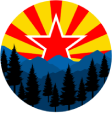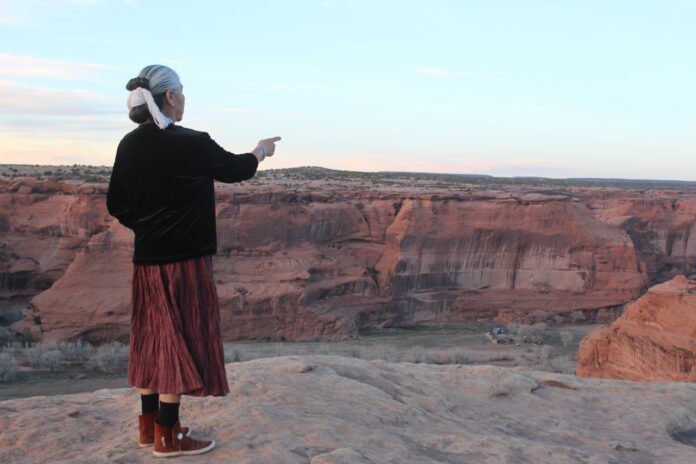CHINLE, Az.- Local Diné gathered at the Voices of the Canyon meeting at the Chinle Chapter House on Feb. 29 to voice their concerns about air tours and irrigation issues.
The Voices of the Canyon meeting was packed, and the issues discussed directly affect the Navajo people’s lives, liberty and their Sacred Canyon. The meeting carried a theme, “Our Canyon, Our Water, Our Choice.”
“We’re going to be talking about two major topics: One will be the Tsaile Dam, and then we’re going to be talking about the air tours that are going to be flying through the canyon here,” said Canyon Keepers member Genny Yazzie.
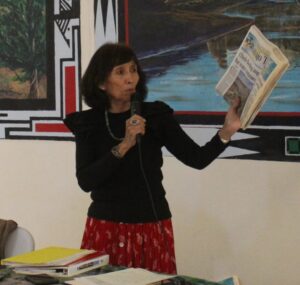
Irrigation
The irrigation concerns stem from the Tsaile Lake and Dam flowing into Canyon de Chelly.
“Right now, there’s a need for management of the Tsaile Lake; that’s been a major problem we’re having and we have no water for our farms,” said Yazzie.
Yazzie described the lack of water in the canyon has had a negative effect on the plants and animals. Roads have also been impacted which has negatively affected business and tourism.
Canyon Keepers member Lupita McCalahan spoke in Navajo and English. “Around 1950 the Tsaile Dam didn’t exist and we miss the natural way of things, recalled McCalahan. “We used to take our our livestock over there because they had sheep keeping in those days and there was no lake, we dipped our sheep into the water the traditional way. The sacredness of nature. When something is off balance or not so much in the natural way, it hurts us.”
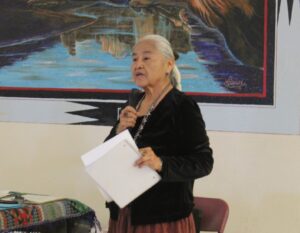
“We have our farms in the canyon, we have our orchards, and livestock in the canyon,” said Yazzie
Yazzie lives inside of the canyon and explained, “They do not have water for their crops during the growing season and have too much water during the flash floods.” Yazzie also explained the canyon has a lot of native plants, tobacco, Navajo tea, and many plants have moved away because of the lack of water.
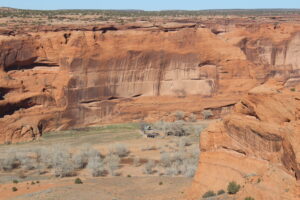
Lisa Draper Richards is from Del Muerto, an area about nine miles from Chinle. She explained her family is the closest to Tsaile Lake. Richards recalled, “My grandfather is Philip Draper Sr. He planted a big apple orchard way up near Big Flow Canyon. We’re the closest family that has grazing area near the lake. The water being gone sure has made a difference in our family orchard.”

Richards explained the dynamics of The Tsaile Dam and Lake.
The water storage capacity was 5,500-acre feet of stored water at the time the lake was filled in 1964. The depth of the dam is 35 feet deep. The Tsaile Dam has a spillway crest elevation of 7,028 feet. Water will accumulate in the lake until the spillway occurs at a surface elevation of 7,029 feet.
Tsaile Reservoir collects water enough from a 60 square mile area that forms the upper Tsaile Creek watershed, high up in the Chuska Mountains. The Tsaile Creek drainage originates near the crest of the Chuska Mountains and flows generally southwest through Canyon Del Muerto to Chinle Wash 25 miles downstream. At this point, Tsaile Creek combines with Chinle Creek flowing out from the larger Canyon de Chelly and flows close by Chinle. Heading downstream, the creek flows towards Many Farms.
Then the water heads near the town of Dennehotso, where the Laguna Creek confluences with Chinle Creek and downstream until Chinle Creek joins the San Juan River. Chinle Creek is an important tributary to the San Juan River before it enters Lake Powell. Now, Tsaile Dam is called a gravity dam, held in place by the force of the water against the dam and the stability of the earth-filled embankment.
Tsaile Dam was designed with two systems of water release. The first one, the technical system, utilizing a 7-foot-wide metal sluice gate located on the Tsaile Creek side of the dam and allows the gate to be manually lifted high enough to allow the water to be released into Tsaile Creek. The non-technical system of water release is the use of a rock spillway cut into the bedrock, forming a channel directing the water through five aqueducts before spilling over the waterfall and into the canyon below.
A 70 foot long, 4 foot high cement berm located within the spillway holds back the lake water until it reaches the overspill when the lake is full and the water crests over the top of the entire berm. In a typical year, stream flow collected into the dam ranges from a low of 25 CFS in the fall to a high of 40 to 65 CFS in the spring. Flooding occurs at 100 CFS during instantaneous peak flows from spring melt runoff, resulting in uncontrolled flooding over the cement berm, that is no longer able to hold the water back.
“There is a need for management of the water flowing through Canyon Del Muerto and Canyon de Chelly,” said Richards.
Molly Claw from Chinle said, ” The major flood that went through last spring, I had to shuttle my sister back and forth in a boat, we need an alert system to warn people of dangerous waters.”
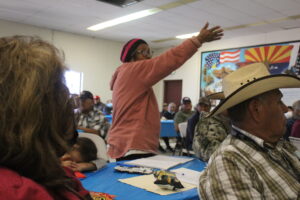
Another issue that was brought up was the presence of Russian Olive plants.
“Russian Olives are taking over, and it’s really choking the canyon so the water can’t spread out and causing erosion. So one thing that needs to get done is to get rid of Russian Olives first,” said Chinle resident Benjamin Anagal.
“We have called up to water resources president’s office and whoever else we can think of to have them release water from the from the dam. And so we’re trying very hard to get that water situation taken care of. We all know that the environment in the canyon has plants and animals. “said Yazzie.
Air Tours: Southwest Safaris
Southwest Safaris is the air tour company offering a tour of Canyon de Chelly from Santa Fe for $795 per person. From the Southwest Safari website: CANYON DE CHELLY CLASSIC WING SAFARI: After touching down at Chinle, AZ, tour members rendezvous at historic lodge for an all-morning backcountry tour of this fabled Canyon with an Indian guide. See Anasazi cliff dwellings, pictographs, traditional Native American farms, 800-foot redrock walls draped with desert tapestry, and water-carved sandstone sculptures. Enjoy a leisurely rest-stop at Antelope House with time for picnic lunch in the shade of rustling cottonwood trees.
Lynn Carranza of the National Park Service said she discovered three companies had been conducting air tours approved by the FAA. Before finding out about the FAA approval, Chinle residents were seeing planes flying low and were very concerned. She asked Chinle residents to obtain tail numbers before finding out the tours were approved.
Chinle residents told Carranza they felt it was an invasion of their privacy.
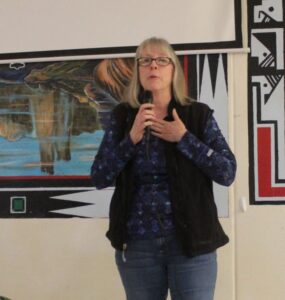
Soon after she found out that the FAA approved some tours during the pandemic. A court ruling said National Parks had to complete their air tour management plans. Carranza told the FAA she had to consult with the community before they could proceed with the air tours.
Chinle resident Violet Hunter raised a question about Bruce Adams who is the founder of Southwest Safaris. “Bruce Adams, founder of Southwest Safaris, serves as professional pilot guide and naturalist. I want to know who this person is that’s going to bring people to our home, to watch us plant, to put us on this plate, to put us in a zoo.”
On Dec.5, Delegate Carl Roessel Slater of the 25th Navajo Nation Council delivered a testimony before the U.S. House Committee on Natural Resources Subcommittee on Oversight and Investigations. The hearing, titled “Limited Access and Damaging Gateway Economies: Examining the National Parks Air Tour Management Program,” included contributions from one federal witness and four non-federal witnesses.
Slater highlighted the risks posed by air tours to the Diné, including intrusion of privacy, potential damage to cultural sites, and environmental impacts. He recounted instances when sacred ceremonies were disrupted by low-flying aircraft, and voiced concerns about potential harm to irreplaceable sacred sites and local wildlife. The close physical presence of even small aircraft can lead to erosion or other forms of disruption and damage, including pollution from aircraft emissions and noise.
A meeting will be held at the end of March. Yazzie said the details have not been finalized but will be announced.
Chinle residents are encouraged to attend the public meeting about air tours on April 16th at 10 a.m. at the Chinle Chapter House, the FAA will be attending.
Canyon Keepers spoke in their traditional Diné language during the Voices of the Canyon meeting and to Mountain Daily Star reporters, translation was possible by our friends, the Canyon Keepers.
